The Birds Nest Fern is native to several warmer climate countries including Australia. It's Botanical name is Asplenium nidus, and there are several species including one with forked fronds. This plant is an Epiphyte in it's natural habitat, meaning that spores ( like small seeds ) lodge and germinate in places like the forks of trees that offer good support, where they grow, and the rosette of fronds collect falling leaves, birds droppings, dead insects etc and these provide nutrients for the plant. Natural rainfall provides water and helps decay the leaves that the plant collects. Birds Nest Ferns also grow happily in garden soil as long as it is kept moist ,shaded from the hot sun and preferably high humidity. Young plants will grow in suitable spots by themselves.
Birds Nest Ferns are suitable for pots and can be grown indoors or outdoors where they add a tropical feel to a garden. Allow a bit of space for this plant, as they grow quite large, having fronds up to 2 metres long. They are best suited to cool temperate, temperate and warmer climates and are common around Sydney gardens, where i took these photos.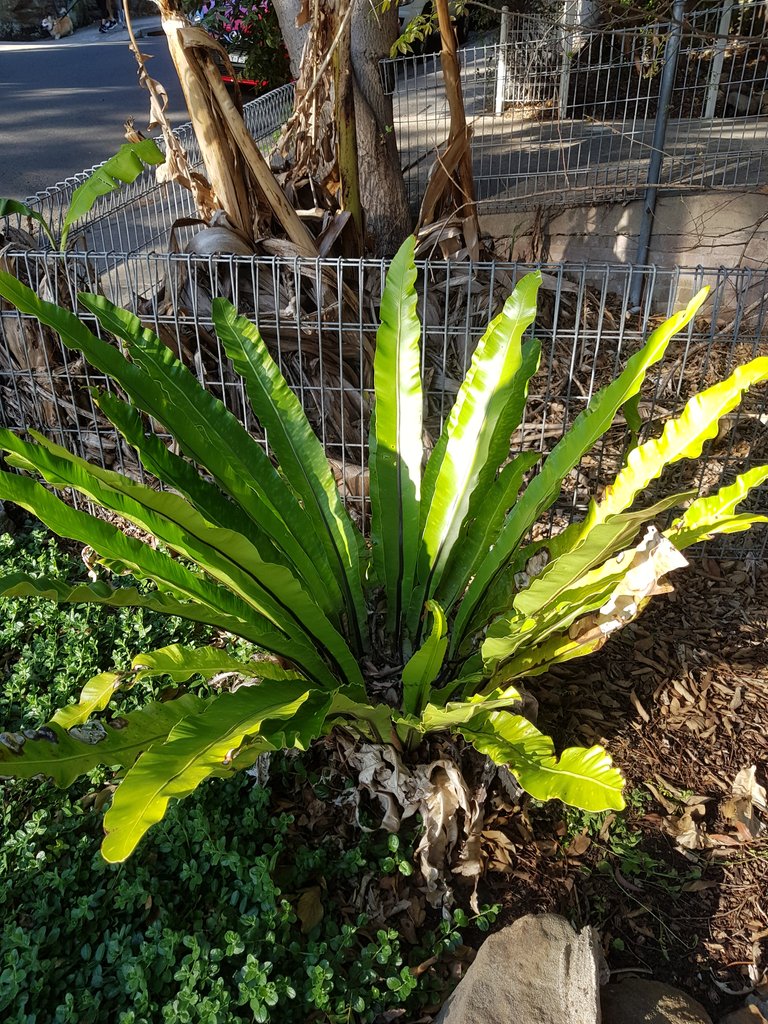
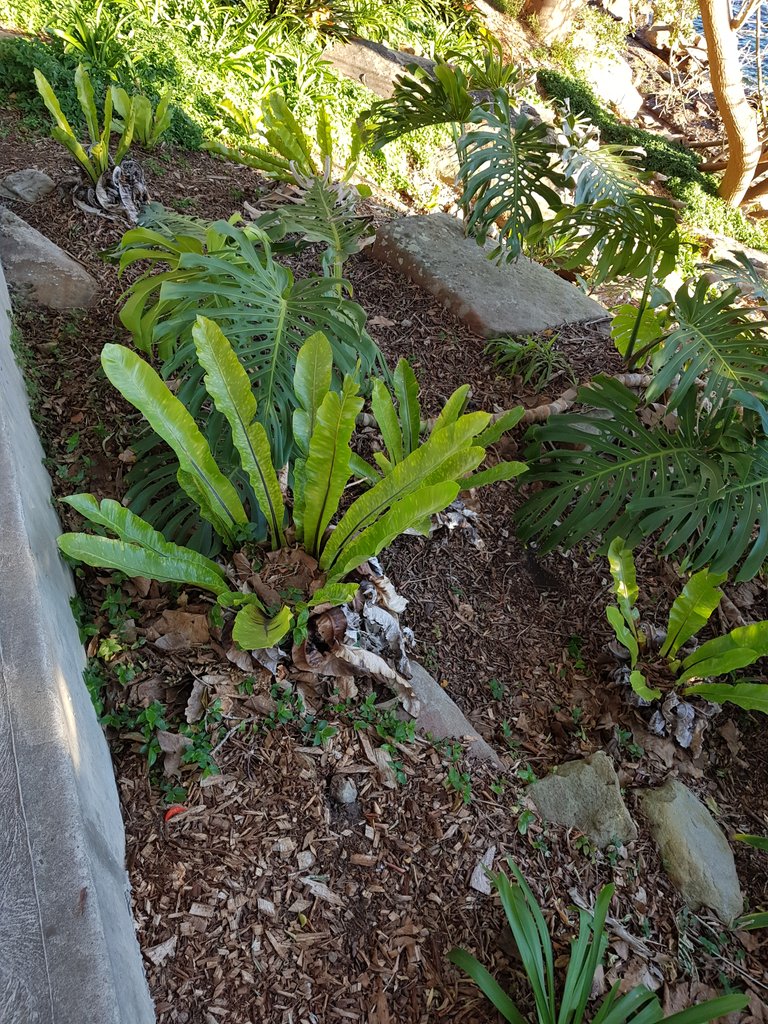
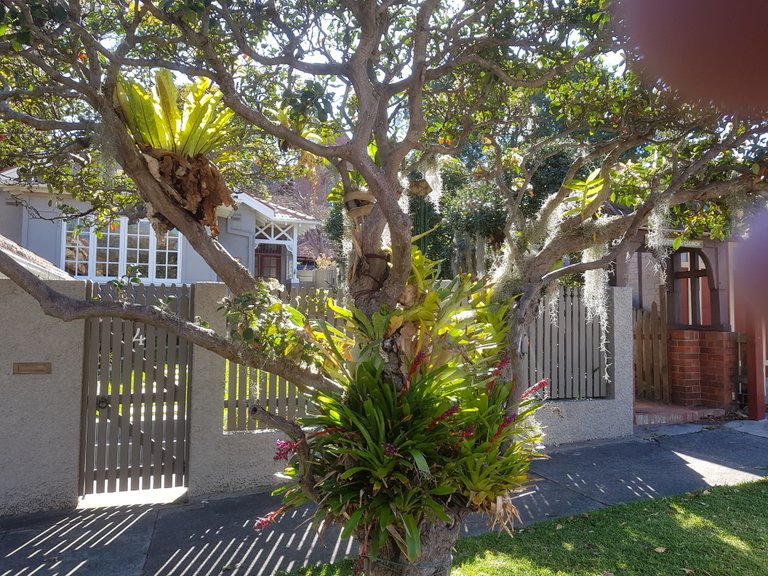
@ctrl-alt-nwo, The Birds Nest Fern already in my home garden.
The bird’s nest fern plant gets its name from the fact that the center of the plant resembles a bird’s nest. It is also occasionally called a crow’s nest fern. Bird’s nest ferns (Asplenium nidus) are identified by their flat, wavy or crinkly fronds. Their appearance can bring to mind a seaweed plant growing on dry land. Bird’s nest fern is an epiphytic fern, which means in the wild it typically grows on other things, like tree trunks or buildings. When you buy it as a houseplant, it will be planted in a container, but it can be affixed to planks and hung on a wall much like staghorn ferns.
Bird’s nest ferns grow best in medium to low indirect light. These ferns are often grown for their crinkly leaves and the light they receive will affect how crinkled the leaves are. A bird’s nest fern that receives more light, for example, will have more crinkled leaves, while one that receives less light will have flatter leaves. Keep in mind that too much light or direct light will cause the fronds on bird’s nest fern to yellow and die.
Source: https://www.gardeningknowhow.com/houseplants/birds-nest-fern/birds-nest-fern-care.htm
Fav. comment Award ! Great Pics, thanks.
The Bird's nest differs from many in appearance because of it's spear like shaped leaves rather than feather or palm like fronds. The leaves (have a brown mid-rib and wavy margin) grow up to about 2ft long from a rosette of fronds where new leaves appear when the plant is producing new growth.
While a plant is young and small it can be placed anywhere in a home or office with the correct conditions provided (light, etc.). Once it matures though, you'll need to provide enough space for the rosette of fronds to spread out over 2ft each side. A conservatory is best suited or a fairly large room once it does mature.
https://www.houseplantsexpert.com/birds-nest-fern.html
Silly Sausage Award ! Thanks for your good choice of Pics.
The Bird's Nest Fern or Asplenium nidus is one of the several popular and beautiful ferns grown as houseplants. The Bird's Nest Fern is easy to care for and suits many homes making it a versatile houseplantFerns like this one can be grown in North facing windows perfectly well and will truly relish the type of light and cooler temperatures these places receive.
In return the Bird's Nest Fern will give you lots of naturally glossy leaves arranged in a circular pattern which resemble a bird's nest (hence the common name for these houseplants).
https://www.ourhouseplants.com/plants/bird-nest-fern
While this fern finds it home in the humid tropics, it can be found growing in and around trees. This may seem a little odd but there is a reason for this relationship. First, the tree provides additional humidity and two, it provides shade.
To successfully grow this fern indoor, we must first replicate the two conditions described above.
The first thing we need to consider is the light requirement of this plant. Light can be tricky when it comes to the Bird’s Nest Fern. The best type of sunlight for this plant is bright light without direct sunlight. If the plant receives too much sunlight, the fronds will become light green or will have burn marks. Having said that, there really nothing wrong with letting the plant have a little early morning or pre-sunset light.
http://www.weekendgardener.net/houseplant-care/how.to.care.for.and.grow.a.birds.nest.fern.htm
I love reading your posts as they giving me great ideas , i thinking when will be the best time to do it on my own as the winter is coming
Shared on twitter promoting good quality content on #Steemit.
#Promo-Steem #steemtalent #JoinSteemit #Steemit
Birds Nest Fern - not just for the empty-nesters. #steemtalent #JoinSteemit #Steemit @Steemit
#Gardening #GardenersWorld
#Plants #Photography #Photographer #Blogger #Blog #Australia
Beautiful plant my friend and epiphytic, rosette-shaped fern with sword-like, undivided fronds growing from a central region. Fronds are smooth-textured, glossy, light green with a dark brown/black midrib, 60 to 120cms long and 7 to 20cms wide. In natural conditions this fern can be seen high up in crooks of trees but is generally planted at ground level, beneath a canopy of trees or tree ferns, preferring filtered light, to light shade. Grows well alongside Orchids and Bromeliads. Likes a loose, enriched, organic soil mix, kept as moist and humid as possible. Do not expose to direct sun, other than early morning sun and avoid frost prone zones and coastal exposure. In the growing season can be fertilised twice weekly with a liquid fertiliser but do not apply to centre of rosette.
SPECIFICATIONS
Dimensions Height: 0.6 to 1m, Width: 1.5m
Aspect Part shade
Origin Eastern Australia, tropical south east Asia
Pests & diseases Snails and slugs in garden situations and Mealy Bug on indoor plants.
Typical sizes 140mm, 200mm, 300mm
Thank you @ctrl-alt-nwo
A source of information: https://www.alpinenurseries.com.au/plant-library/asplenium-nidus/
Amazing plant @ctrl-alt-nwo! Commonly known as a bird’s nest fern, Asplenium nidus has many names. For instance, in Malaysia it is called: Rumah Langsuyar, in the Philippines: Pakpak-lauin and in China: Tai wan shan su hua. There are also many synonyms for this fern, which include Asplenium ficifolium, Asplenium antiquum, Neottopteris mauritiana, Neottopteris nidus. It belongs to the Plantae Kingdom , Pteridophyta phylum, Polypodiopsida class, Polypodiales order, the Aspleniaceae family, Asplenium genus.
Geographical distribution:
This fern is a native of tropical Africa , Australia and tropical Asia. Asplenium nidus either grow terrestrially on the ground, or epiphytically on the trees. Sometimes they grow on rocks (Piggott, 1988).
The sword-shaped fronds grow from the centre of the plant to form an inverted cone. The fronds are very long approximately 50-120cm, and 10-20cm wide, also the leaves or fronds are light green, often crinkled, with a smooth-edged blade and a black midrib that is obvious. The sporangia develop in clusters called sori, covered by an elongated indusium on the back of the fronds. It has roots for absorption of water and minerals from the soil (Koh, 2009). In terms of size this alters according to the habitat (Piggott, 1988).
A source: https://blogs.reading.ac.uk/tropical-biodiversity/2014/01/asplenium-nidus-2/
Aha! I have this fern in my garden, my friend gave it to me three years ago. Now they are quite big! I wish I could eat their leaves! So green and crunchy!
Posted using Partiko iOS
A great plant, when I saw that it was in a tree, I understood why it got its name. it is very similar to a bird's nest.
Have seen them and yeah they do look pretty nice as well. While recently I was able to get few images and most of them were about different kind of leaves, well this kind of reminded me of those images .
It is a very beautiful plant @ctrl-alt-nwo and makes a nice decoration to trees too. It thrives in a wet environment.
Luxurious ferns stand out not only the status of an ancient plant. These garden stars do not know the leaves of equal beauty, lacy and fascinating, by the ability to instantly change the atmosphere in the ensemble and create strange shady thickets.
One of the distinguishing features of ferns has always been a clean, saturated color of greenery, but in color, these plants are not so simple as they seem at first glance. Indeed, among the ferns there are spectacular unusual species that can surprise with unusual textures and unusual shades of the palette, the original form. However, with all their glamor, these plants never lose their legendary mystery. This is an amazing racialism. Thank you for sharing information about this.
https://www.botanichka.ru/article/paporotniki/
Asplenium nidus is an epiphytic species of fern in the family Aspleniaceae, native to tropical southeastern Asia, eastern Australia, Hawaii, Polynesia, Christmas Island, India, and eastern Africa. It is known by the common names bird's-nest fern (a name shared by other aspleniums) or simply nest fern.
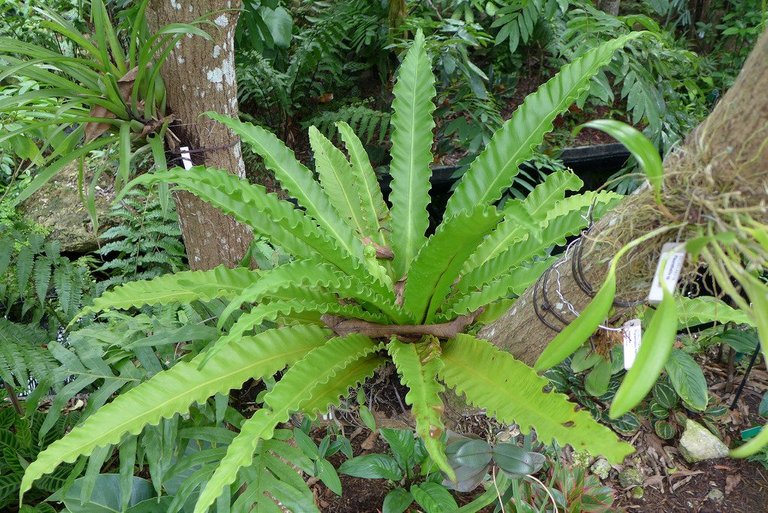
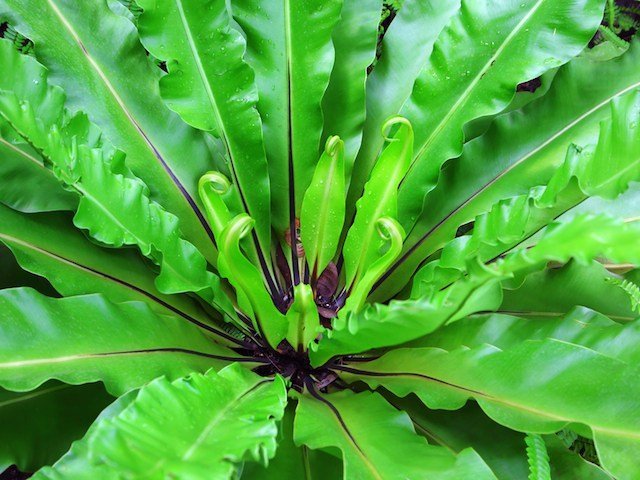
Source
Source
A 2015 molecular study found that Asplenium nidus is polyphyletic, meaning that some populations were not closely related to others—A. nidus from Madagascar, Vanuatu and New Guinea were more closely related to other species than each other. Hence a revision with sampling of the species across its range was required to delineate the taxon and identify cryptic species.
Source
magoo-2 found a series of multi accounts of a same owner is following your articles to cheat your generous rewards.
magoo-2 found these accounts are suspicious & can be multi accounts of a single owner. Conclusion is based on last 1 year transactions:
@alves
@devid1996
@mhyeasin
@sadikulaziz
@msena
@kilee
@ripon1
@googlefighter
@melianasagita
@ashasikder
@hichako
magoo-2
Check our latest multi comment spam update report
It looks like that you have tracked those accounts where only made transaction based on who comments in sir @ctrl-alt-nwo post. But transaction not means multi accounts. I have a relation with my several friends in facebook group where I sell my steem or sbd. Some of them also follow me and i think some of them also made comment on sir @ctrl-alt-nwo post. That not means I'm a multi user. And I'm not a mad that I use 11 accounts as you recommend, it's totally foolish idea.
Indeed, i saw this kind of plants and birds are always love to made their nest every branch of this plants..
interesting knowing about it for the first time thanks for sharing this post the comments really help a lot too :)
@ctrl-alt-nwo, Birds Nest Fern is really awesome in my opinion and in my observation it's reflecting as this plant is reflecting as plants with the Multi Hands which are spreading to hug the essence of nature. And i strongly believe that these kind of plants can make our environment more beautiful and more pleasant and these plants also hold the creative essence. And i also believe and in my opinion the creator is a Artist and these natural beauties are live art pieces.
Wishing you an great day and stay blessed. 🙂
Yes, I can find it in my area and this type of plant often grows attached to a large tree. this plant also has black fibers or feathers the size of a stick.
Ferns that belong to the asplenium genus, one of which is glimpsed by lovers of ornamental plants. The form of ferns from this genus has similarities to bird nests. Because of its resemblance, ornamental plant lovers call it a bird's nest nail. Bird nest nails multiply with spores. These spores are located at the bottom of the leaf and are brown. Life of asplenium is epiphytic. This means that in his life only attached to the host plant. Bird nest nails take nutrients from organic materials that rot and stick to the host plant.

The type of asplenium that is often maintained by the community is Asplenium nidus. But fanatic plant lovers are not satisfied with this type. Currently breeders are developing unique and rare bird nest nails. With the mutation treatment, the chicks that occur can produce variegata and cristata types. Cross breeds can produce new hybrids. The results of the mutation treatment are temporary. If people are not good at maintaining this bird's nest, it's easy to change. Plants that occur from mutations tend to return to their original nature. The results of crosses are permanent. This hybrid is expected by fans of ferns.
Asplenium treatment is easy. This plant needs a moist, wet and shaded place. In asplenium treatment should avoid direct exposure to sunlight. Leaves exposed to direct sunlight will be seen burning. The leaves will be yellow until finally brown and die. Providing organic matter is needed to add nutrients. Organic ingredients such as leaf litter, coconut fiber and straw can be used by hobbyists in asplenium treatment.
Source:
https://www.google.co.id/url?sa=t&source=web&rct=j&url=https://biodiversitywarriors.org/m/isi-katalog.php%3Fidk%3D5920&ved=2ahUKEwjcrL3-6YXeAhULK48KHfZdC4oQFjAXegQIBRAB&usg=AOvVaw0g8UBv1wy07eTbQt2PrwwM
The name and the plant are great. I never saw this plant, I know just the real Bird Nest. The last picture ist wonderful!
How it looks: Ferns are quite an interesting group of plants to grow indoors because of the various types of fronds they display, so you could have three ferns in one room from the same class and genera that look kind of unrelated.
The Bird's nest differs from many in appearance because of it's spear like shaped leaves rather than feather or palm like fronds. The leaves (have a brown mid-rib and wavy margin) grow up to about 2ft long from a rosette of fronds where new leaves appear when the plant is producing new growth.
Displaying: While a plant is young and small it can be placed anywhere in a home or office with the correct conditions provided (light, etc.). Once it matures though, you'll need to provide enough space for the rosette of fronds to spread out over 2ft each side. A conservatory is best suited or a fairly large room once it does mature.
Care level: The two main conditions to provide well is enough humidity and to protect the leaves from direct sunlight (they become scorched), although some sunlight is ideal for them. If a person has sufficient living space and can follow the straight forward care instructions below, anyone can grow and maintain them.
source
Wow so very beautiful garden, thanks for sharing.really nice for lovely Birds Nest Fern tress.....
Resteem
Bird's Nest Fern (Asplenium nidus) is a relatively carefree plant with an upright, clumping form and large fronds.
Light: Bird's Nest Fern grows best in filtered or indirect light. An east- or north-facing window is ideal.
Watering: Water your plant as necessary to keep the potting mix evenly moist but not soggy. These plants also benefit from moderate humidity when grown indoors. The best way to increase the humidity around your plants is to run a humidifier nearby. You can also set plants in trays filled with pebbles or gravel. Add water to a level just below the tops of the pebbles (if the potting mix in the pots comes in contact with the water, the mix will draw water into the pot, which will cause the mix to become saturated, eventually leading to rot). Refill trays frequently to replace water lost through evaporation. (Our Humiditrays perform the same function without the need for pebbles.)
Temperature: Bird's Nest Fern prefers to be kept at regular room temperature, with nighttime temperatures above 60°F.
Fertilizer: During the growing season (generally April into September) fertilize potted plants once a month using a houseplant formula mixed at 1/2 strength. Withhold fertilizer in fall and winter, when most plants rest.
source
Our planet is 300% spherical)) Different continents, different in their current type of plant, and their preferences and methods of reproduction are the same. Víscum - family Santalaceae lives in our area. This plant has a very sticky juice. The seeds are glued to the paws of birds and spread to other trees. I have long been writing about this plant article. It was interesting to read your article. Wonderful representative of the world of plants.
beautiful! (btw, just put up the "super" bullish scenario for silver and how the "ratio" favors the "white metal"..thank you..
The times have passed when ferns reigned on the planet, the species struck them with a variety of leaf shapes and inhabited all the spaces of the planet, and now they form thickets mostly in damp and warm countries. For the modern gardener, original plants are of decorative value and can perfectly decorate the interior. I found some photos with different types of fern. I think you will like it. Thank you
https://womanadvice.ru/paporotniki-vidy-i-osobennosti-vyrashchivaniya
Bird’s Nest Fern Care – How To Grow Bird’s Nest Fern
When most people think of ferns, they think of feathery, airy fronds, but not all ferns actually look like this. The bird’s nest fern is an example of a fern that defies our preconceived ideas of what a fern should look like. Even better is the fact that a bird’s nest fern plant makes an excellent low light houseplant.
About the Bird’s Nest Fern Plant
The bird’s nest fern plant gets its name from the fact that the center of the plant resembles a bird’s nest. It is also occasionally called a crow’s nest fern. Bird’s nest ferns (Asplenium nidus) are identified by their flat, wavy or crinkly fronds. Their appearance can bring to mind a seaweed plant growing on dry land.
Bird’s nest fern is an epiphytic fern, which means in the wild it typically grows on other things, like tree trunks or buildings. When you buy it as a houseplant, it will be planted in a container, but it can be affixed to planks and hung on a wall much like staghorn ferns.
How to Grow Bird’s Nest Fern
Bird’s nest ferns grow best in medium to low indirect light. These ferns are often grown for their crinkly leaves and the light they receive will affect how crinkled the leaves are. A bird’s nest fern that receives more light, for example, will have more crinkled leaves, while one that receives less light will have flatter leaves. Keep in mind that too much light or direct light will cause the fronds on bird’s nest fern to yellow and die.
Care for a Bird’s Nest Fern In addition to light, another important aspect of bird’s nest fern care is its watering. Under ideal circumstances, all ferns would like to have consistently moist, but not wet, soil. However, part of the reason that bird’s nest fern makes an ideal houseplant is that it will tolerate soil that dries out from time to time. Furthermore, this plant does not require the same level of humidity that many other kinds of ferns need, making the care for a bird’s nest fern far more forgiving to the occasionally forgetful houseplant owner than other ferns.
https://www.gardeningknowhow.com/houseplants/birds-nest-fern/birds-nest-fern-care.htm
Bird's nest ferns (Asplenium nidus) are actually one of two Asplenium species found in cultivation. The other, often called the spleenwort or mother fern (Asplenium bulbiferum), is much harder to grow and looks nothing like its cousin. These ferns are naturally epiphytic, and in their rainforest homes, they can be found growing high in the crooks of trees.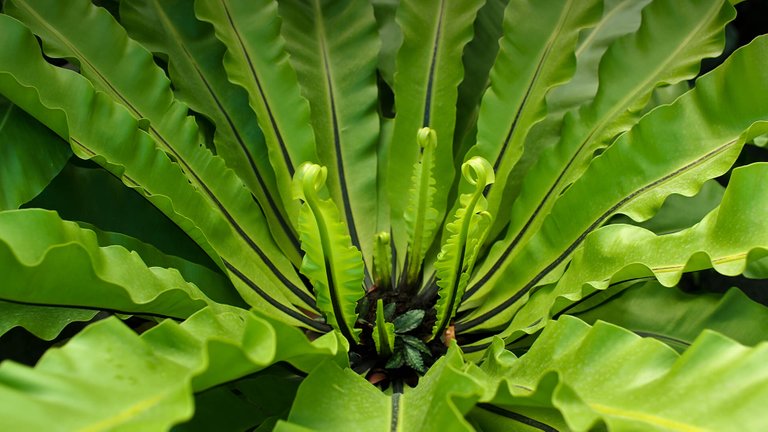

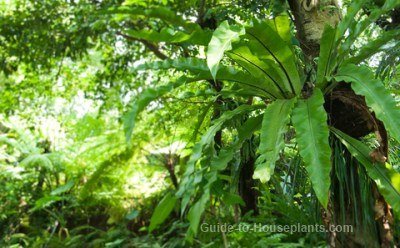 Water: These are true jungle plants—keep their compost moist and provide the highest humidity possible.Temperature: Bird's nest ferns will begin to suffer below about 55 F for prolonged periods. They are best kept between 70 F and 80 F, with high humidity. A warming pad will often help dormant plants.
Water: These are true jungle plants—keep their compost moist and provide the highest humidity possible.Temperature: Bird's nest ferns will begin to suffer below about 55 F for prolonged periods. They are best kept between 70 F and 80 F, with high humidity. A warming pad will often help dormant plants.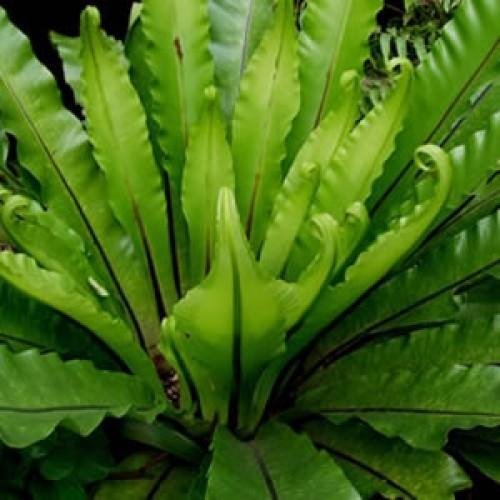
They grow in a series of erect, spoon-shaped, and apple-colored fronds that rise from a central rosette. Healthy plants can have fronds up to three feet, but this is rare in most indoor situations.These are beautiful plants but require a bit of babying to reach their fullest potential.
If you follow the correct growing conditions for your bird's nest fern, it will likely live for many years and always look its best.Light: Filtered light to light shade. Don't expose to direct sun other than very early morning sun.
Source.
The Bird's Nest Fern or Asplenium nidus is one of the several popular and beautiful ferns grown as houseplants.

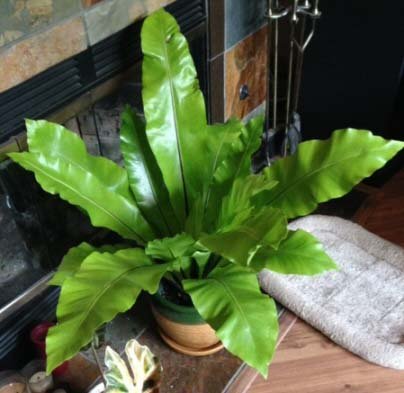
image source
image source
Ferns like this one can be grown in North facing windows perfectly well and will truly relish the type of light and cooler temperatures these places receive.
content source
Botanical Name: Asplenium nidus
Bird Nest Fern is one of the easiest types of ferns to grow. This tropical native is fast-growing and will live for many years with good care.
In its natural habitat, it grows as an epiphyte (a plant that grows on trees) in the warm, moist, tropical rain forests. Despite its tropical beginnings, it adapts well to being a house plant. Place your potted fern where it is out of direct sun and away from drafts, which can scorch the fronds. Provide humidity and you'll keep it healthy.

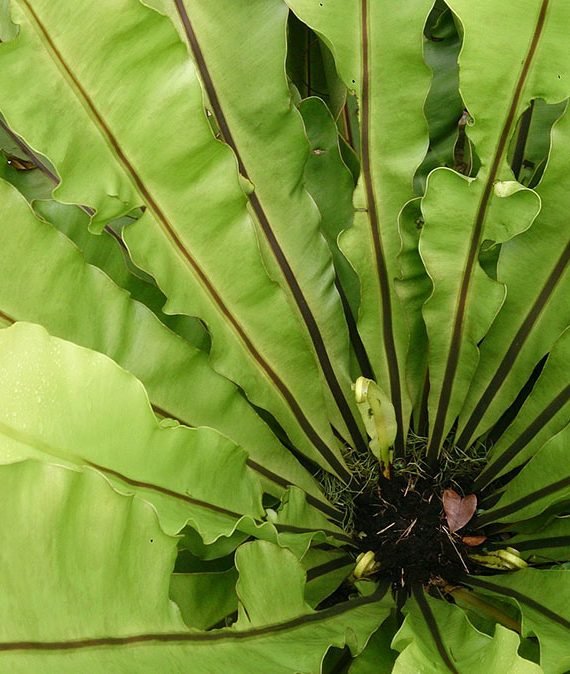
This unique fern grows in the form of a deep rosette of large, shiny, spear-shaped fronds. New fronds unfurl from the center of the plant. Its fronds are fragile, so I'd put this fern where passersby won't brush up against it.
As Bird Nest Fern ages, the oldest, outer fronds will turn brown. This is normal. You can cut them off at the base to keep the plant looking neat.
Those upright fronds tend to be dust-catchers. Keep the broad, shiny fronds dust-free by spraying with water and gently wiping them with a damp cloth. Never use leafshine products on ferns because it can severely damage their delicate fronds.
Repot young plants in spring, every couple years or when the roots fill the pot. If you find that the roots are attached to the pot, run a knife around the inside to loosen them before you can remove the rootball. You may need to break the pot to remove it. It's a good idea to use a container with drainage holes to avoid soggy soil. Take care not to pack down the potting mix; this fern likes a loose mixture.
This fern's problems are few. Watch for scale insects, that look like small, brown discs on fronds. If you find an invasion of these pests, spray with soapy water followed by clean water. Don't use insecticides on ferns because they are easily damaged by chemicals.
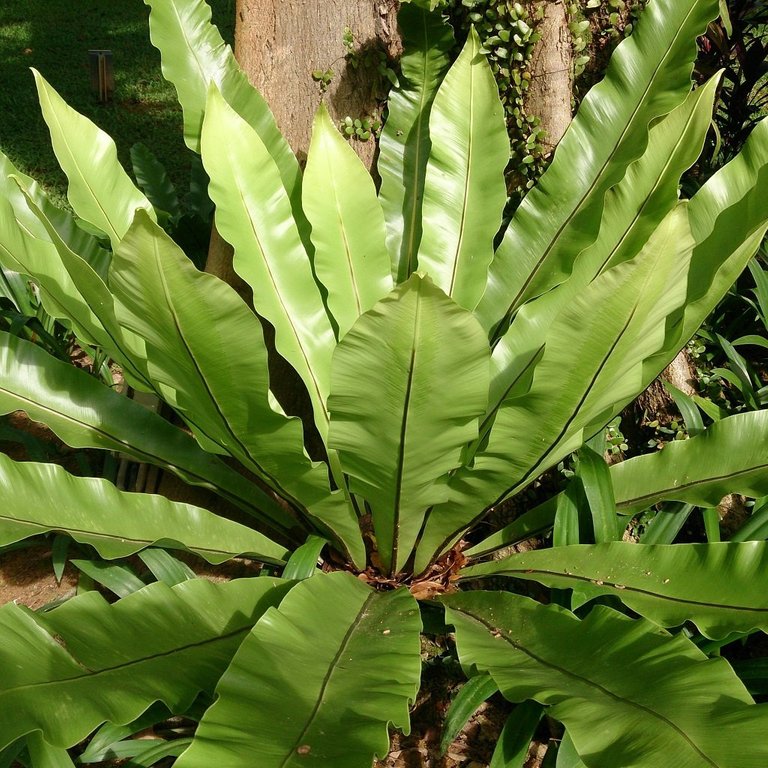
http://www.guide-to-houseplants.com/birds-nest-fern.html
Features: The frond is fresh green, a broad and very long ribbon (50-150cm) with slightly wavy edges and a black central rib. The spores appear on the underside in fine lines. The fronds emerge in a rosette around a central stem which is usually not visible. Dead leaves collect in this 'nest' of fronds and are held firmly in place as new fronds emerge. Roots from the central stem grow into the dead leaves, further consolidating the decaying leaves into a huge spongy mass. This mass soaks up rainwater, while the ongoing decay releases nutrients. Thus the fern is self-sufficient in food and water even though it lives high up from the ground. As the older fronds die, they droop downwards forming a skirt of dry fronds under the younger, green fronds.
source
This is a far out fern with a far out name! I first saw this Crested Japanese Bird’s Nest Fern, whose botanic name is Asplenium antiquum “Leslie”, at our farmers market and had to have it. I love those wild, wavy edges and the crispy noise it makes when touched. I must say, this plant reminds me of an unusual green that I’d put in my salad.
https://www.joyusgarden.com/wp-
content/uploads/2015/02/P1040897_new.jpg
source
Variant names
Malay: Daun semun, paku langsuyar, paku padan, rumah langsuyar, selimbar.
Chinese: Niaochao jue.
The bird’s-nest fern (Asplenium nidus) is a large, leafy fern commonly found on wayside trees in Singapore, particularly the rain tree. The fern, which grows at the base of large branches, has a unique ability to trap water and develop its own store of humus.
Description
The bird’s-nest fern is an epiphyte plant that can be found in Asia, Australia, and Africa. It has a stout erect rhizome (stem) that bears a rosette of simple leaves (fronds) to form a “nest”. The stem is usually not visible from the top. Beneath the nest of fronds is a large, spongy mass of roots. The nest traps fallen leaves and other debris, which eventually decompose to become humus. When it rains, large quantities of water are absorbed by the sponge of roots. In this way, the plant is self-sufficient in acquiring its food and water, so much so that it provides a habitat for the growth of other ferns and mosses, and even home for small animals.
Usage and potential
Food: The bird’s-nest fern is non-poisonous and occasionally eaten by aboriginal tribes in Malaysia.
Medicine: There are several medicinal uses of the bird’s-nest fern by the Malaysian native tribes. Infusion of the fronds is used to ease labour pains. The leaves can also be pounded in water and used as a lotion to treat fever. Two young fronds can be eaten when they are still coiled as a contraceptive, and tea made from fronds can be used for general weakness.
Content Source
In my country colombia you can find a lot of this plants
Based in you post i learned a lot more about them. Regards
magoo-2 found a series of multi accounts of a same owner is following your articles to cheat your generous rewards.
magoo-2 found these accounts are suspicious & can be multi accounts of a single owner. Conclusion is based on last 30 days transactions:
@martha75
@dim753
magoo-2
Check our latest multi comment spam update report
Hi @magoo-2 are you stupid? @martha75 is my mom please search more and more before repeat and repeat the same wrong thing.
Green plants are always good for planting . Green color gives beautiful look to place . Also good for climate . Thanks for blog
magoo-2 found a series of multi accounts of a same owner is following your articles to cheat your generous rewards.
magoo-2 found these accounts are suspicious & can be multi accounts of a single owner. Conclusion is based on last 1 year transactions:
@pardeepkumar
@sami100
magoo-2
Check our latest multi comment spam update report
Ferns in the genus Asplenium are referred to as spleenworts—asplenium is the Greek word for spleen, and wort is a general word for plant. At one time, people thought ingesting these ferns medicinally would cure disorders of the spleen.
SIDE DISH
The newly emerging, curled fronds (called crosiers) of Asplenium australasicum are a popular vegetable in Taiwan.
UNIQUE ADDITION
Asplenium goudeyi is only found on Lord Howe Island off the coast of Australia, and it was only recently described for science, in 1996.
IN CELEBRATION
In old Hawaii, the leaves of Asplenium nidus, called ekaha, adorned hula altars and were used in canoe tree-cutting ceremonies.
source
Sometimes plants provide a much-needed escape—not just by working with them, but also in their appearance in general. Take the bird’s nest fern: One look at this popular houseplant—with its long, waxy, apple-green fronds—sends us daydreaming to a tropical paradise.
source
Nice plant. Green color is giving refreshness to eyes. This would be good plant for humans, birds and nature . Thanks
Asplenium Nidus (Bird's Nest Fern)
About the Bird's Nest Fern
The Bird's Nest Fern or Asplenium nidus is one of the several popular and beautiful ferns grown as houseplants.
Ferns like this one can be grown in North facing windows perfectly well and will truly relish the type of light and cooler temperatures these places receive.
In return the Bird's Nest Fern will give you lots of naturally glossy leaves arranged in a circular pattern which resemble a bird's nest (hence the common name for these houseplants).
These Ferns have very few problems, are cheap to purchase and readily available. They're particularly good indoor plants for bathrooms or a frequently used kitchen because these places tend to have a steamy atmosphere.
This is important because a Bird Nest Fern needs some humidity to really thrive indoors, they'll still cope and deal with an average room but for that extra shine and extra large size you'll need to be misting regularly.
Alternatively, if you don't have the time for all that misting, the Bird Nest Fern is an ideal plant to keep in a home terrarium or glass bottle garden, these enclosed spaces create naturally moist and protective environments that many types of plants, including most ferns, will do well in.
https://www.ourhouseplants.com/plants/bird-nest-fern
Growing Bird's Nest Fern (Asplenium nidus)
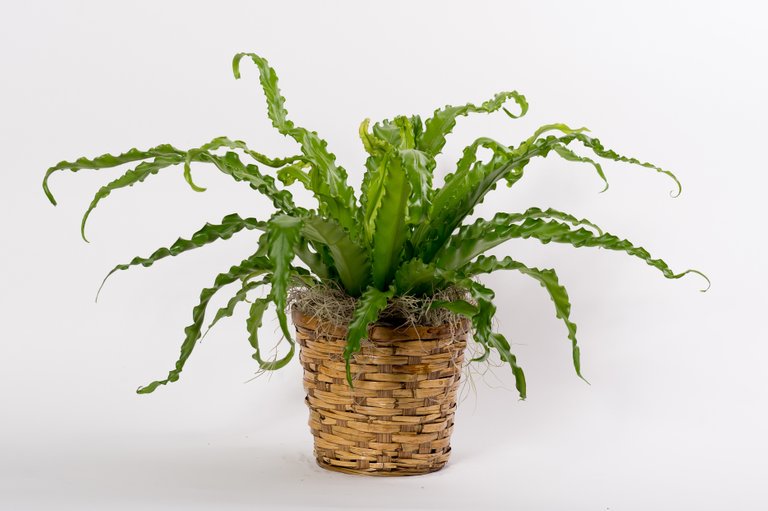
Bird's Nest Fern (Asplenium nidus) is a relatively carefree plant with an upright, clumping form and large fronds.

Light: Bird's Nest Fern grows best in filtered or indirect light. An east- or north-facing window is ideal.

Watering: Water your plant as necessary to keep the potting mix evenly moist but not soggy. These plants also benefit from moderate humidity when grown indoors. The best way to increase the humidity around your plants is to run a humidifier nearby. You can also set plants in trays filled with pebbles or gravel. Add water to a level just below the tops of the pebbles (if the potting mix in the pots comes in contact with the water, the mix will draw water into the pot, which will cause the mix to become saturated, eventually leading to rot). Refill trays frequently to replace water lost through evaporation. (Our Humiditrays perform the same function without the need for pebbles.)
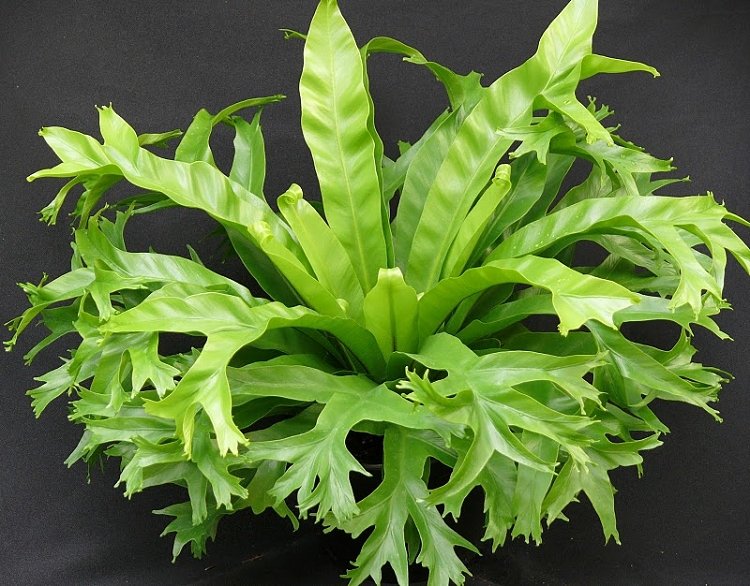
Temperature: Bird's Nest Fern prefers to be kept at regular room temperature, with nighttime temperatures above 60°F.
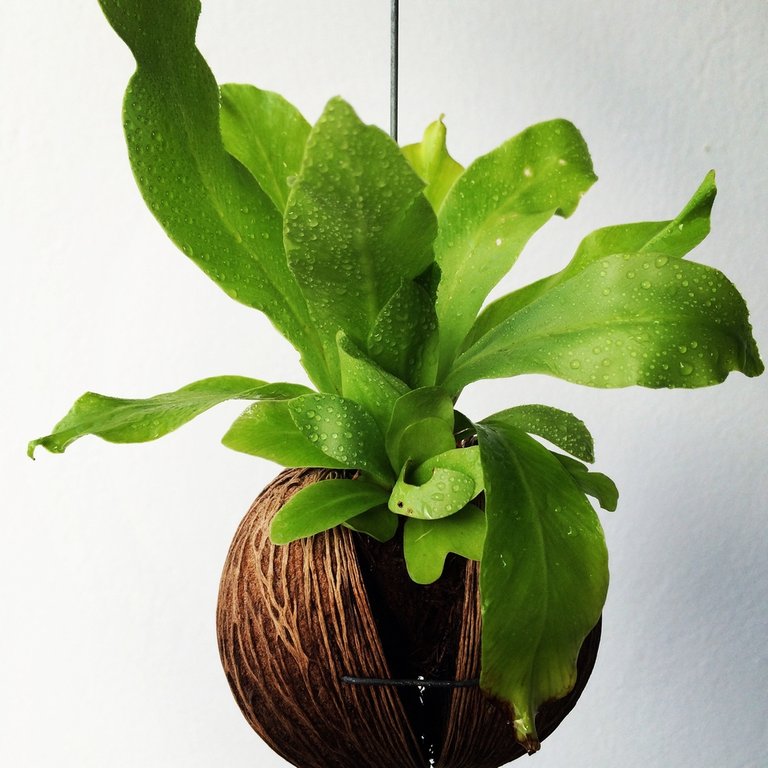
Fertilizer: During the growing season (generally April into September) fertilize potted plants once a month using a houseplant formula mixed at 1/2 strength. Withhold fertilizer in fall and winter, when most plants rest.
https://www.whiteflowerfarm.com/how-to-grow-birds-nest-fern
The Bird's Nest Fern or Asplenium nidus is one of the several popular and beautiful ferns grown as houseplants. The Bird's Nest Fern is easy to care for and suits many homes making it a versatile houseplantFerns like this one can be grown in North facing windows perfectly well and will truly relish the type of light and cooler temperatures these places receive.

In return the Bird's Nest Fern will give you lots of naturally glossy leaves arranged in a circular pattern which resemble a bird's nest (hence the common name for these houseplants).
These Ferns have very few problems, are cheap to purchase and readily available. They're particularly good indoor plants for bathrooms or a frequently used kitchen because these places tend to have a steamy atmosphere.

This is important because a Bird Nest Fern needs some humidity to really thrive indoors, they'll still cope and deal with an average room but for that extra shine and extra large size you'll need to be misting regularly.
Alternatively, if you don't have the time for all that misting, the Bird Nest Fern is an ideal plant to keep in a home terrarium or glass bottle garden, these enclosed spaces create naturally moist and protective environments that many types of plants, including most ferns, will do well in.
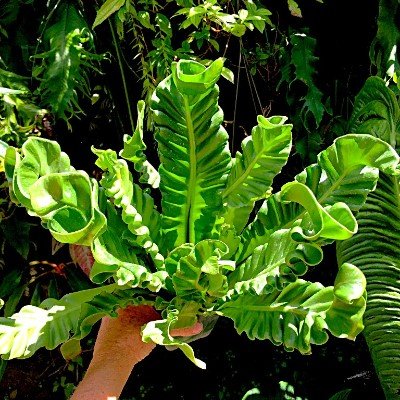
The older glass bottle garden are a little old fashioned we'd admit, but as design pieces themselves they have started to become more popular again with interior designers. You may have a larger selection to pick from at car boot sales or in antique shops, but Amazon have a few of the more modern fashion trends to give you some inspiration. Take a look at the links below.
https://www.ourhouseplants.com/plants/bird-nest-fern
magoo-2 found a series of multi accounts of a same owner is following your articles to cheat your generous rewards.
magoo-2 found these accounts are suspicious & can be multi accounts of a single owner. Conclusion is based on last 1 year transactions:
@jacqueline5
@african1
@merina
@marizanne
@miller1
@jerry1994
@aarshi
@nawmi
@maisha
@jenifer2
@masud1
@jerry2
@selina2
magoo-2
Check our latest multi comment spam update report
The Asplenium nidus is an epiphytic species known as the Bird's nest fern that roots itself to trees in it's natural habitat and warmer climates.
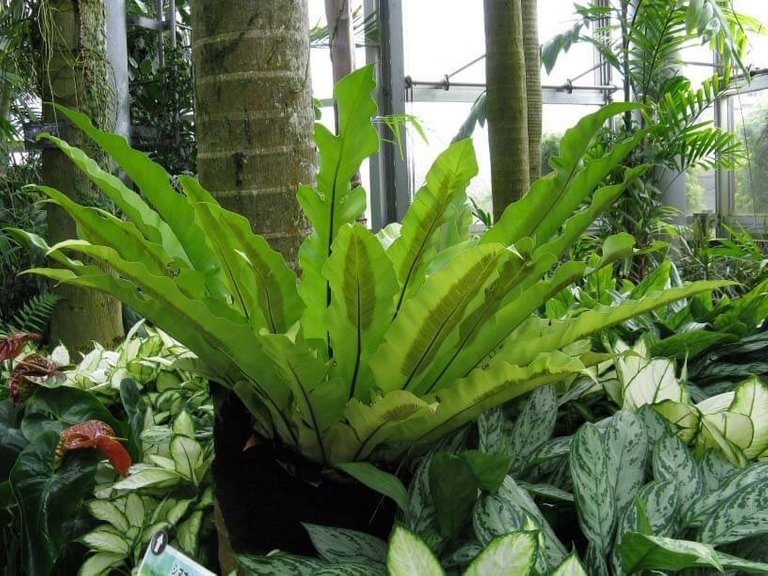
image sources
inage source
From the range of ferns that can be grown indoors this plant has larger leaflets than most and gives that large full leaf foliage plant appearance.
article source
magoo-2 found a series of multi accounts of a same owner is following your articles to cheat your generous rewards.
magoo-2 found these accounts are suspicious & can be multi accounts of a single owner. Conclusion is based on last 1 year transactions:
@alves
@devid1996
@mhyeasin
@sadikulaziz
@msena
@kilee
@ripon1
@googlefighter
@melianasagita
@ashasikder
@hichako
magoo-2
Check our latest multi comment spam update report
very very beautiful photography. I like this photos

So cool photography and nature trees .great information.
The Bird's Nest Fern or Asplenium nidus is one of the several popular and beautiful ferns grown as houseplants. The Bird's Nest Fern is easy to care for and suits many homes making it a versatile houseplantFerns like this one can be grown in North facing windows perfectly well and will truly relish the type of light and cooler temperatures these places receive.
In return the Bird's Nest Fern will give you lots of naturally glossy leaves arranged in a circular pattern which resemble a bird's nest (hence the common name for these houseplants).
These Ferns have very few problems, are cheap to purchase and readily available. They're particularly good indoor plants for bathrooms or a frequently used kitchen because these places tend to have a steamy atmosphere.
This is important because a Bird Nest Fern needs some humidity to really thrive indoors, they'll still cope and deal with an average room but for that extra shine and extra large size you'll need to be misting regularly.
source
magoo-2 found a series of multi accounts of a same owner is following your articles to cheat your generous rewards.
magoo-2 found these accounts are suspicious & can be multi accounts of a single owner. Conclusion is based on last 1 year transactions:
@alves
@devid1996
@mhyeasin
@sadikulaziz
@msena
@kilee
@ripon1
@googlefighter
@melianasagita
@ashasikder
@hichako
magoo-2
Check our latest multi comment spam update report
Asplenium nidus
Bird's-nest fern is a common name applied to several related species of epiphytic ferns in the genus Asplenium. They grow in a tight, nest-like clump with a lingulate leaf rosette and are usually epiphytic, growing in trees.
https://images-na.ssl-images-amazon.com/images/I/71TbtTJYYtL.SX425.jpg
source
magoo-2 found a series of multi accounts of a same owner is following your articles to cheat your generous rewards.
magoo-2 found these accounts are suspicious & can be multi accounts of a single owner. Conclusion is based on last 1 year transactions:
@saikr
@christian.danny
@aaeesha
@sarah.taylor
magoo-2
Check our latest multi comment spam update report
Bird's-nest fern
Bird's-nest fern is a common name applied to several related species of epiphytic ferns in the genus Asplenium. They grow in a tight, nest-like clump with a lingulate leaf rosette and are usually epiphytic, growing in trees.
Species known as bird's nest fern include:
A. nidus (bird's-nest fern)
A. australasicum (crow's-nest fern)
A. antiquum
A. serratum (wild bird's-nest fern)
This page is an index of articles on plant species (or higher taxonomic groups) with the same common name (vernacular name). If an internal link led you here, you may wish to edit the linking article so that it links directly to the intended article.
https://en.m.wikipedia.org/wiki/Bird%27s-nest_fern
magoo-2 found a series of multi accounts of a same owner is following your articles to cheat your generous rewards.
magoo-2 found these accounts are suspicious & can be multi accounts of a single owner. Conclusion is based on last 30 days transactions:
@dtube2
@masud1234
magoo-2
Check our latest multi comment spam update report
Wow really amazing photography. good article and hard writing
For your post propagation.
Upvote/Resteem